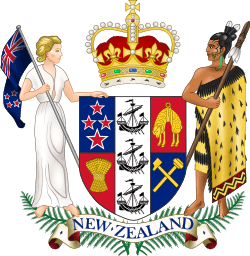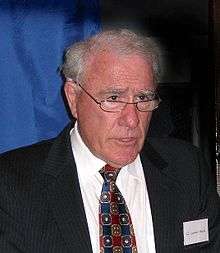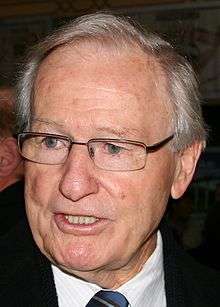Prime Minister of New Zealand
| Prime Minister of New Zealand | |
|---|---|
|
| |
| Style | The Right Honourable[1] |
| Residence | Premier House |
| Appointer | Governor-General of New Zealand |
| Term length |
At Her Majesty's pleasure (dependent on parliamentary support) |
| Inaugural holder |
Henry Sewell As Colonial Secretary |
| Formation | 7 May 1856 |
| Deputy | Deputy Prime Minister of New Zealand |
| Website | primeminister.govt.nz |
 |
| This article is part of a series on the politics and government of New Zealand |
| Constitution |
|
|
|
|
Related topics |
The Prime Minister of New Zealand (Māori: Te Pirimia o Aotearoa) is the primary minister of the Crown, chairman of the Cabinet, and head of government in New Zealand. The office exists by long-established convention (originating in New Zealand's former colonial power, the United Kingdom) that stipulates the monarch's representative, the Governor-General, must select as prime minister the person most likely to command the confidence of the New Zealand House of Representatives. This individual is typically the leader of the political party that holds the largest number of seats in that chamber. John Key of the National Party has served in the office since 19 November 2008; he won re-election in 2011 and in 2014.
The title "Prime Minister" had made its first formal appearance in the 1873 Schedule of the Civil List Act, but originally the head of government was entitled Colonial Secretary or First Minister. This was formally changed in 1869 to "Premier". This title remained in use for over thirty years, being informally changed by Richard Seddon to "Prime Minister" in 1901 during his tenure in office.[2] Following the declaration of New Zealand as a Dominion in 1907, the term "Prime Minister" has been used exclusively.
Responsibilities and powers
The role of the Prime Minister is not formally defined, being based on constitutional convention rather than specific legislation. According to these conventions, the Prime Minister is leader of Cabinet (itself a body existing by convention), and takes a co-ordinating role. The Cabinet Manual 2008 provides an outline of the Prime Minister's powers and responsibilities.[3]
The post of Prime Minister is, like other ministerial positions, an appointment by the Governor-General "during the Queen's pleasure". However, the convention has long since been established that the Prime Minister must have and retain the support of a majority of members of parliament. Historically, this has usually meant that the Prime Minister is the parliamentary leader of the largest political party in the House of Representatives.
Principal adviser to the Sovereign
By constitutional convention, the Prime Minister holds formal power to advise the Sovereign. This means that as long as the Prime Minister has the confidence of Parliament, he or she alone may advise the Queen on:[4]
- appointment or dismissal (recall) of the Governor-General[5]
- amendments to the Letters Patent 1983, which most recently occurred in 2006; and
- the conferment of New Zealand honours (except for honours in the personal gift of the monarch).
Principal adviser to the Governor-General
As head of government, the Prime Minister alone has the right to advise the Governor-General to:[4]
- appoint, dismiss, or accept the resignation of Ministers;
- dissolve Parliament and call a general election.
Head of government
The Prime Minister is regarded by convention as "first among equals".[6] He does indeed hold the most senior post in the administration, but is also required to adhere to any decisions taken by Cabinet. The actual ability of the New Zealand Prime Minister to give direct orders is largely limited; most of the position's power comes about through other means, such as:
- The ability to set the Cabinet agenda, thereby controlling what issues will be discussed.
- The ability to appoint and dismiss ministers. The extent to which this power can be exercised varies between different parties; the Labour Party, for example, places most of this responsibility in the hands of the Caucus, leaving the Prime Minister only with the power to choose which portfolios a minister is given. Furthermore, the MMP electoral system has complicated this, as the Prime Minister may have to consult with another party leader.
- The influence a Prime Minister is likely to have as leader of the dominant party. These powers may give more direct control over subordinates than is attached to the Prime Minister's role itself.
- The power gained simply from being central to most significant decision-making, and from being able to comment on and criticise any decisions taken by other ministers.
The Prime Minister can call elections by advising the Governor-General to dissolve Parliament. The Governor-General may reject this advice if the Prime Minister has recently lost a vote of confidence (that is, the Governor-General would be using his reserve powers), but so far none have done so.
Deputy Prime Minister
Within the last fifty years, a convention has also developed of appointing a Deputy Prime Minister. The Deputy typically holds important ministerial portfolios and becomes Acting Prime Minister in the absence or incapacity of the Prime Minister. The Deputy is commonly a member of the same party as the Prime Minister, but not necessarily so; in coalition Governments, the parliamentary leader of a support party may be offered the post.
Salary and perquisites
Under the Remuneration Authority Act 1977, and the Members of Parliament (Remuneration and Services) Act 2013, the Prime Minister's salary is determined annually by the Remuneration Authority, an independent body established by Parliament to set salaries for Members of Parliament and other government officials.[7]
For the fiscal year extending from 1 July 2016 to 30 June 2017, the Prime Minister's salary is NZ$459,739, plus a tax-free allowance of NZ$22,229 to cover out-of-pocket official expenses such as meals, gifts, and entertainment.[8] In addition, like all other Ministers and Members of Parliament, the Prime Minister receives annual allowances for travel and lodging, as do the Prime Minister's spouse and children.[9]
The Prime Minister's official residence is Premier House, Tinakori Road, Wellington.[10] On appointment to office, the Prime Minister receives the title The Right Honorable for life.[1]
The Prime Minister's governmental work is supported by the politically neutral Department of the Prime Minister and Cabinet. A separate Private Office of the Prime Minister provides advice and support on political party matters.[11]
History

Assuming that Sewell is counted as the first Prime Minister, thirty-eight people have held the office since it was established. Some of these people have held it on several different occasions, with the record for maximum number of times being shared between William Fox and Harry Atkinson (both of whom served four times). The longest that anyone has served in the office is thirteen years, a record set by Richard Seddon. The first holder of the office, Henry Sewell, led the country for the shortest total time; his only term lasted only thirteen days (the shortest term actually belonged to Harry Atkinson, whose third term lasted only seven days, but Atkinson served longer than Sewell in total). The youngest to hold office was Edward Stafford, who was 37 years old when he became Premier in 1856. The oldest was Walter Nash, who was 78 years old when he left office in 1960 (and 75 upon taking office in 1957).
New Zealand is also one of the few countries in the world to have had two female heads of government, and one of only two countries to have had a female head of government directly succeed another (the other country being Sri Lanka). The first female New Zealand Prime Minister was Jenny Shipley, who replaced Prime Minister Jim Bolger in mid-1997. She was succeeded by the next Prime Minister, Helen Clark, in 1999.
Colony

On becoming the Colony of New Zealand in 1841, New Zealand was directly governed by a Governor, appointed by the Colonial Office. Self-government was established in 1853, following the New Zealand Constitution Act 1852, and the 1st Parliament met on 24 May 1854.
The exact origins of the office of Prime Minister are disputed. Use of the words "prime minister" as a descriptive term date back to the 1st Parliament, where they are applied to James FitzGerald and Thomas Forsaith. FitzGerald and Forsaith had no official titles, however, and New Zealand had not yet obtained self-rule. As such, they are not usually considered Prime Ministers in any substantive sense.
The first person to be formally appointed to a position of leadership was Henry Sewell, who formed a government at the beginning of the Second Parliament. Despite his formal leadership role, however, his only actual title was Colonial Secretary, a position comparable to the Minister of Internal Affairs. His successor, William Fox, was also given a formal leadership role, but was not Colonial Secretary. It was not until Frederick Weld, the sixth person appointed to formal leadership, that a substantive leadership title – Premier–appeared. Weld's successor, Edward Stafford, briefly changed the title to First Minister but it was soon afterwards restored to Premier by William Fox. From that point, Premier became the usual designation. Towards the end of the nineteenth century the term Prime Minister arose as a common alternative to Premier and Richard Seddon used the title almost exclusively. Seddon's successor, William Hall-Jones, was officially appointed Prime Minister rather than Premier. The title "Prime Minister" has been used ever since.
Initially, Premiers acted as advisers to the Governor. This began to change during the first tenure of Edward Stafford. Stafford met with his ministers and made decisions outside of the official Executive Council, forming the New Zealand Cabinet.[12] Stafford also clashed with the Governor over control of Maori affairs, which was eventually to fall within the Premier's powers.[13] A further extension of the Premier's power came during John Ballance's tenure, 1891–1893. The Premier gained the ability to restrict the term of appointments to the Legislative Council of New Zealand.
Dominion and Realm

In 1907 Parliament passed a declaration declaring New Zealand as the "Dominion of New Zealand". This led to the reconstituting of the office of Governor as Governor-General, and a subsequent narrowing of that office's power. As a result, the Prime Minister's powers were again expanded.[13]
In 1967, Prime Minister Keith Holyoake advised the Queen to appoint Sir Arthur Porritt, the first New Zealand–born Governor-General.[13]
Until the premiership of Labour's Helen Clark, it was customary for senior members of the legislature, executive and judiciary – including the Prime Minister – to be appointed to the British Privy Council, granting them the style "Right Honourable". This practice was discontinued at the same time as the abolition of Knighthoods and Damehoods in 2000 from the New Zealand honours system. National's John Key became Prime Minister in 2008 and restored the titles, but did not resume appointments to the Privy Council, meaning Key was styled "The Honourable".[14] However, on 3 August 2010 the Queen granted the Prime Minister, Governor-General, Speaker of the House of Representatives and Chief Justice the style "Right Honourable" upon appointment. This decision will not affect past officeholders.[15]
Two prime ministers who died in office were buried in mausoleums; William Massey (died 1925) in the Massey Memorial in Wellington, and Michael Joseph Savage (died 1940) in the Savage Memorial at Bastion Point in Auckland.
Living former Prime Ministers
As of December 2016, there are five living former New Zealand Prime Ministers, as seen below.
- Living former Prime Ministers of New Zealand





The most recent Prime Minister to die was David Lange (served 1984–1989), on 13 August 2005 aged 63.
Lists
Below are selected lists of the thirty-eight individuals have so far held the premiership.
- List of Prime Ministers of New Zealand
- List of Prime Ministers of New Zealand by age
- List of Prime Ministers of New Zealand by date of birth
- List of Prime Ministers of New Zealand by place of birth
- List of Prime Ministers of New Zealand by tenure
See also
- List of New Zealand ministries
- List of Governors-General of New Zealand
- List of current heads of state and government
References
- 1 2 "THE RIGHT HONOURABLE". Department of the Prime Minister and Cabinet. Retrieved 13 October 2012.
- ↑ "Prime Minister: The Title "Premier"". Te Ara – An Encyclopaedia of New Zealand, 1966. Retrieved 27 August 2007.
- ↑ "Cabinet Manual 2008". cabinetmanual.cabinetoffice.govt.nz. Cabinet Office of New Zealand. Retrieved 31 August 2016.
- 1 2 "Cainet Manual 2008". Department of the Prime Minister and Cabinet. 2008. Retrieved 21 September 2011.
- ↑ The power of recall has never been exercised by a Prime Minister in New Zealand. Three Governors were recalled during the colonial period, but on the advice of British ministers.
- ↑ "Premiers and prime ministers". The Encyclopedia of New Zealand. Retrieved 4 September 2016.
- ↑ "Clients' remuneration: Members of Parliament, including the Prime Minister and Ministers". The Remuneration Authority. Retrieved 4 December 2016.
- ↑ "Parliamentary Salaries and Allowances Determination 2016" (PDF). The Remuneration Authority. Retrieved 4 December 2016.
- ↑ "Members of Parliament (Accommodation Services for Members and Travel Services for Family Members and Former Prime Ministers) Determination 2014". New Zealand Legislation. Parliamentary Counsel Office. Retrieved 4 December 2016.
- ↑ "Premiers and prime ministers: Support Services and Statues". Te Ara: The Encyclopedia of New Zealand. Retrieved 4 December 2016.
- ↑ "Premiers and prime ministers: Support Services and Statues". Te Ara: The Encyclopedia of New Zealand. Retrieved 4 December 2016.
- ↑ Bohan, Edward (1994). Edward Stafford, New Zealand's first statesman. Christchurch, New Zealand: Hazard Press. ISBN 0-908790-67-8.
- 1 2 3 Gavin McLean (October 2006), The Governors, New Zealand Governors and Governors-General, Otago University Press, ISBN 978-1-877372-25-4
- ↑ "Titles of Dames, Knights to be restored – Key". 8 March 2009.
- ↑ "New rules for use of the Right Honourable". Buckingham Palace. 3 August 2010.

